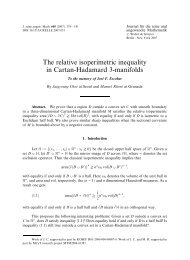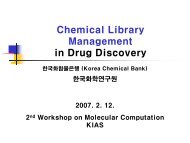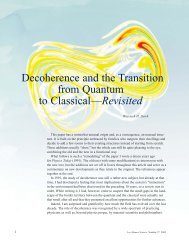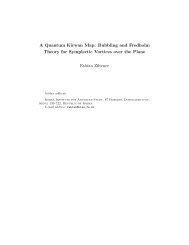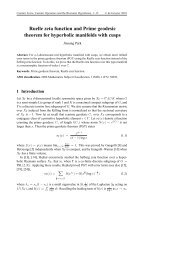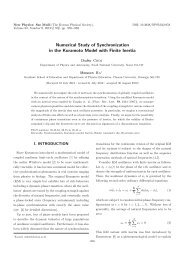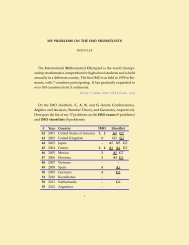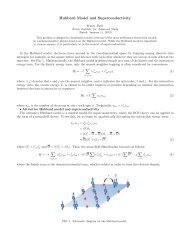Testing the Standard Model of Cosmology Using BAO data - KIAS
Testing the Standard Model of Cosmology Using BAO data - KIAS
Testing the Standard Model of Cosmology Using BAO data - KIAS
You also want an ePaper? Increase the reach of your titles
YUMPU automatically turns print PDFs into web optimized ePapers that Google loves.
<strong>Testing</strong> <strong>the</strong> <strong>Standard</strong> <strong>Model</strong> <strong>of</strong><br />
<strong>Cosmology</strong> <strong>Using</strong> <strong>BAO</strong> <strong>data</strong><br />
Arman Shafieloo<br />
Institute for <strong>the</strong> Early Universe<br />
30 th June 2011, <strong>KIAS</strong>, Seoul-Korea<br />
Future <strong>of</strong> Large Scale Structure Formation
(Present)t<br />
<strong>Standard</strong> <strong>Model</strong> <strong>of</strong> <strong>Cosmology</strong><br />
Universe is Flat<br />
Universe is Isotropic<br />
Universe is Homogeneous (large scales)<br />
Dark Energy is Lambda (w=-1)<br />
Power-Law primordial spectrum (n_s=const)<br />
Dark Matter is cold<br />
All within framework <strong>of</strong> FLRW
<strong>Standard</strong> <strong>Model</strong> <strong>of</strong> <strong>Cosmology</strong><br />
Vanilla <strong>Model</strong><br />
• Homogeneous and Isotropic<br />
FLRW Flat Lambda Cold Dark<br />
Matter Universe (LCDM) with<br />
power–law form <strong>of</strong> <strong>the</strong> primordial<br />
spectrum<br />
• It has 6 main parameters:
Era <strong>of</strong> Precision <strong>Cosmology</strong> <br />
Cosmological Parameters from WMAP<br />
Table from LAMBDA website
Beyond <strong>the</strong> <strong>Standard</strong> <strong>Model</strong> <strong>of</strong><br />
<strong>Cosmology</strong><br />
• The universe may be more complicated than its<br />
current standard model (Vanilla <strong>Model</strong>).<br />
• There might be some extensions to <strong>the</strong> standard<br />
model in defining <strong>the</strong> cosmological quantities.<br />
• This needs proper investigation, using advanced<br />
statistical methods, high performance computational<br />
facilities and high quality observational <strong>data</strong>.
(Present)t<br />
<strong>Standard</strong> <strong>Model</strong> <strong>of</strong> <strong>Cosmology</strong><br />
Universe is Flat<br />
Universe is Isotropic<br />
Universe is Homogeneous (large scales)<br />
Dark Energy is Lambda (w=-1)<br />
Power-Law primordial spectrum (n_s=const)<br />
Dark Matter is cold<br />
All within framework <strong>of</strong> FLRW
Parameter estimation within a<br />
cosmological framework<br />
Harisson-Zel’dovich (HZ) Power-Law (PL) PL with Running (RN)<br />
Assumptions from <strong>the</strong> early universe<br />
Tables from NASA - LAMBDA website
Parameter estimation within a<br />
cosmological framework<br />
Harisson-Zel’dovich (HZ) Power-Law (PL) PL with Running (RN)<br />
Assumptions from <strong>the</strong> early universe<br />
Tables from NASA - LAMBDA website
Dark Energy Reconstruction<br />
• Any uncertainties in matter density is bound to<br />
affect <strong>the</strong> reconstructed w(z).<br />
Assumptions from <strong>the</strong> early universe can affect<br />
reconstruction <strong>of</strong> <strong>the</strong> late universe.<br />
H(z) =<br />
'<br />
)<br />
(<br />
d dz<br />
!<br />
#<br />
"<br />
d L<br />
(z)<br />
1+ z<br />
$ *<br />
&,<br />
% +<br />
-1<br />
ω<br />
DE<br />
=<br />
2(1 +<br />
(<br />
3<br />
H<br />
1−<br />
(<br />
H<br />
z)<br />
Hʹ′<br />
) −1<br />
H<br />
0 2<br />
3<br />
) Ω )<br />
0M<br />
(1 + z<br />
Shafieloo et al, MNRAS 2006 ; Shafieloo MNRAS 2007<br />
Quite tricky to work with
Future SNAP <strong>data</strong><br />
wz () = w+<br />
w<br />
0 1<br />
z<br />
1+<br />
z<br />
erroneous<br />
Ω<br />
0m<br />
= 0.22<br />
true<br />
Ω<br />
0m<br />
= 0.27<br />
P-value = 26%<br />
erroneous<br />
Ω<br />
0m<br />
= 0.32<br />
Sahni, Shafieloo & Starobinsky, PRD 2008<br />
Clarkson, Cortes & Bassett JCAP 2007<br />
Shafieloo & Clarkson PRD 2010
Late Universe and Dark Energy <strong>Model</strong>s<br />
• Lambda-CDM: The most favorite model<br />
• Brane <strong>Model</strong>s<br />
• Quintessence and Quiessence <strong>Model</strong>s<br />
• Phantoms, Ghosts, demons<br />
• Modified Gravity<br />
• etc...<br />
2<br />
H ( z)<br />
⎡⎡<br />
3<br />
dz<br />
= ⎢⎢Ω<br />
(1 + ) + Ω exp[ ∫ 0<br />
3 1 ]<br />
2<br />
M<br />
z<br />
DE<br />
H ⎣⎣<br />
1+<br />
z<br />
0<br />
( )<br />
⎤⎤<br />
+ w(<br />
z)<br />
⎥⎥ ⎦⎦
Dark Energy Parameterizations<br />
F =<br />
L<br />
4!d L<br />
2<br />
Supernovae Ia as<br />
<strong>Standard</strong>ized Candles<br />
<strong>BAO</strong> as standard ruler<br />
1. Fitting functions for d_l(z)<br />
Most general form <br />
2. Fitting functions for DE density<br />
3. Fitting functions for EOS
Y. Gong, JCAP (2005)
Changing <strong>the</strong> strategy:<br />
• Instead <strong>of</strong> looking for w(z) and exact<br />
properties <strong>of</strong> dark energy at <strong>the</strong> current<br />
status <strong>of</strong> <strong>data</strong>, we can concentrate on a<br />
more reasonable problem:<br />
Λ OR<br />
NOT Λ
wz () =−0.7<br />
wz ( ) =−1.3<br />
2 2 3<br />
H ( z) = H ⎡⎡<br />
0 ⎣⎣Ω 0m(1 + z)<br />
+Ω<br />
DE<br />
⎧⎧ z 1 + wz ( ') ⎫⎫<br />
Ω<br />
DE<br />
= (1 −Ω0m)exp ⎨⎨3 ∫ dz ' ⎬⎬<br />
0<br />
⎩⎩ 1 + z ' ⎭⎭<br />
⎤⎤<br />
⎦⎦<br />
V. Sahni, A. Shafieloo, A. Starobinsky, PRD 2008
Om diagnostic<br />
Om()<br />
z<br />
h<br />
2<br />
() z −1<br />
= + z<br />
3 −<br />
(1 ) 1<br />
V. Sahni, A. Shafieloo, A. Starobinsky, PRD<br />
2008<br />
arXive:0807.3548<br />
Also look at:<br />
C. Zunckel & C. Clarkson, PRL 2008<br />
arXive:0807.4304<br />
Om(z) is constant only<br />
for FLAT LCDM model<br />
w<br />
w<br />
w<br />
=−1 → Om( z)<br />
=Ω<br />
Ω<br />
0m<br />
0m<br />
om<br />
LCDM<br />
Phantom<br />
Quintessence<br />
We Only Need h(z)
To find cosmological quantities and parameters<br />
<strong>the</strong>re are two general approaches:<br />
1. Parametric methods<br />
Easy to confront with cosmological observations to put constrains on <strong>the</strong><br />
parameters, but <strong>the</strong> results are highly biased by <strong>the</strong> assumed models and<br />
parametric forms.<br />
2. Non Parametric methods<br />
.<br />
Difficult to apply on <strong>the</strong> raw <strong>data</strong>, but <strong>the</strong> results will less biased and more reliable<br />
and independent <strong>of</strong> <strong>the</strong>oretical models or parametric forms.
Non Parametric methods <strong>of</strong> Reconstruction <br />
Usually involves binning and smoothing<br />
F<br />
=<br />
L<br />
d<br />
2<br />
4π<br />
L
Method <strong>of</strong> Smoothing<br />
A. Shafieloo, U. Alam, V. Sahni, A. Starobinsky, MNRAS (2006)<br />
A. Shafieloo, MNRAS (2007)<br />
A. Shafieloo & C. Clarkson PRD (2010)<br />
Smoothing function<br />
(error-sensitive)
w1<br />
( z)<br />
w( z)<br />
= w0<br />
+<br />
1+<br />
z<br />
Shafieloo, Alam, Sahni, Starobinsky, MNRAS 2006<br />
Reconstructed w(z) by<br />
smoothing method<br />
Reconstructed w(z) by using<br />
CPL fit.<br />
Chevallier et al (2001) and Linder (2003)
h(z)<br />
Uncorrelated estimation <strong>of</strong> <strong>the</strong><br />
expansion history.<br />
Wang and Tegmark PRD 2005<br />
A. Riess et al, APJ 2006<br />
Gold06<br />
A. Shafieloo, MNRAS 2007
<strong>Model</strong> Independent Reconstruction <strong>of</strong> <strong>the</strong> Expansion History<br />
<strong>of</strong> <strong>the</strong> Universe as a Null Test for <strong>the</strong> Cosmological Constant<br />
Smoothing<br />
Method<br />
Shafieloo & Clarkson, PRD 2010<br />
Nesseris & Shafieloo, MNRAS 2010<br />
Genetic<br />
Algorithm
<strong>Model</strong> Independent Reconstruction <strong>of</strong> H(z)<br />
Smoothing Supernovae <strong>data</strong><br />
Real time cosmology<br />
Age <strong>of</strong> passively evolving galaxies<br />
Volume distance from baryon<br />
acoustic oscillation measurements
<strong>Model</strong> Independent Reconstruction <strong>of</strong> H(z)<br />
Smoothing Supernovae <strong>data</strong><br />
Real time cosmology<br />
Age <strong>of</strong> passively evolving galaxies<br />
Volume distance from baryon<br />
acoustic oscillation measurements
Deriving h(z) from <strong>BAO</strong><br />
Observable<br />
Effective dilation<br />
distance<br />
Comoving sound horizon at<br />
baryon drag epoch
Deriving h(z) from <strong>BAO</strong><br />
Observable <strong>BAO</strong><br />
Effective dilation<br />
distance<br />
Comoving sound horizon at<br />
baryon drag epoch<br />
Observable<br />
CMB
Deriving h(z) from <strong>BAO</strong>
Deriving h(z) from <strong>BAO</strong><br />
Percival et. al. 2010<br />
LAMBDA website<br />
Riess et. al. 2011
Deriving h(z) from <strong>BAO</strong><br />
Om diagnostic
A. Shafieloo and C. Clarkson,<br />
Phys. Rev. D (2010)
Alcock-Paczynski Measurement<br />
• An Alcock-Paczynski measurement can be applied to<br />
cosmological objects as well as an isotropic process<br />
such as <strong>the</strong> 2-point statistics <strong>of</strong> galaxy clustering<br />
(Ballinger et al. 1996)<br />
Scale Distortion<br />
Parameter
C. Blake et. al, in prepration, WiggleZ Survey: Alcock-Paczynski measurement<br />
Amplitude <strong>of</strong> systematic errors in measurements <strong>of</strong> <strong>the</strong> scale distortion<br />
parameter F(z) in four redshift slices relative to its fiducial value F_fid<br />
(FLCDM with matter density <strong>of</strong> 0.27), marginalized over <strong>the</strong> growth rate<br />
and galaxy bias b^2.
Combining <strong>the</strong> information from supernovae<br />
<strong>data</strong> and AP measurements<br />
Smoothing method reconstruct D_A(z) using supernovae <strong>data</strong> in<br />
a model independent way.<br />
(Shafieloo et al 2006, Shafieloo 2007, Shafieloo and Clarkson 2010)<br />
Assumption <strong>of</strong> curvature (here assuming flat universe) allow us<br />
to relate h(z) and distance measurements.<br />
AP measurements <strong>of</strong> distortion parameter F(z) put additional<br />
constraints on <strong>the</strong> reconstructed results through consistency<br />
check between <strong>the</strong> D_A(z) and H(z).<br />
Smoothing method can be modified to include SN Ia and AP<br />
measurements simultaneously to reconstruct <strong>the</strong> expansion<br />
history <strong>of</strong> <strong>the</strong> universe.
C. Blake et. al, in prepration
(Present)t<br />
<strong>Standard</strong> <strong>Model</strong> <strong>of</strong> <strong>Cosmology</strong><br />
Universe is Flat<br />
Universe is Isotropic<br />
Universe is Homogeneous (large scales)<br />
Dark Energy is Lambda (w=-1)<br />
Power-Law primordial spectrum (n_s=const)<br />
Dark Matter is cold<br />
All within framework <strong>of</strong> FLRW
Universe is Flat FLRW metric<br />
Shafieloo & Clarkson, PRD 2010
Conclusion<br />
• <strong>BAO</strong> links <strong>the</strong> early and late universe. It is currently providing us<br />
with more and more valuable information about <strong>the</strong> universe.<br />
• The current standard model <strong>of</strong> cosmology seems to work fine<br />
confronting with <strong>BAO</strong> <strong>data</strong>.<br />
• This does not mean all <strong>the</strong> o<strong>the</strong>r models are wrong.<br />
• It is important to analyze <strong>the</strong> <strong>data</strong> in a model independent way.<br />
• Challenging <strong>the</strong> standard model is more affordable and realistic<br />
than trying to reconstruct <strong>the</strong> underlying model <strong>of</strong> <strong>the</strong> universe.<br />
• Future <strong>data</strong> will break many degeneracies and probably we can<br />
distinguish between many models. We should wait and see how<br />
long <strong>the</strong> standard model can survive.
Coming soon!<br />
A new diagnostic <strong>of</strong> dark energy,<br />
tailored to fit <strong>BAO</strong> <strong>data</strong>



